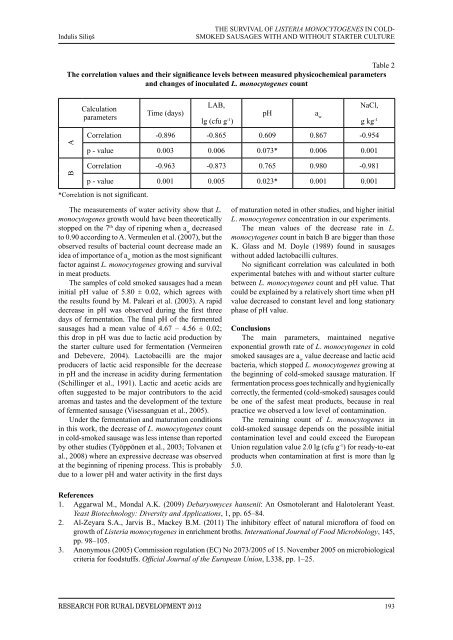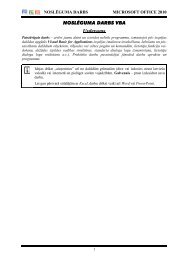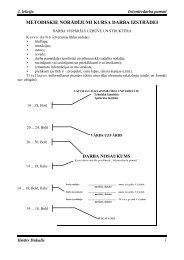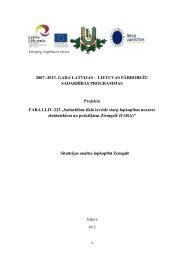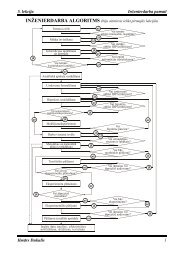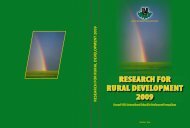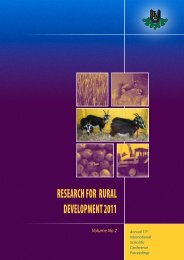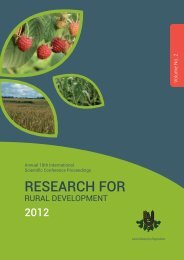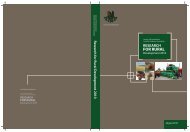Indulis SiliņšTHE SURVIVAL <strong>OF</strong> LISTERIA MONOCYTOGENES IN COLD-SMOKED SAUSAGES WITH AND WITHOUT STARTER CULTURETable 2The correlation values and their significance levels between measured physicochemical parametersand changes of inoculated L. monocytogenes countACalculationparametersTime (days)LAB,lg (cfu g -1 )pH a wNaCl,g kg -1Correlation -0.896 -0.865 0.609 0.867 -0.954p - value 0.003 0.006 0.073* 0.006 0.001BCorrelation -0.963 -0.873 0.765 0.980 -0.981p - value 0.001 0.005 0.023* 0.001 0.001*Correlation is not significant.The measurements of water activity show that L.monocytogenes growth would have been theoreticallystopped on the 7 th day of ripening when a wdecreasedto 0.90 according to A. Vermeulen et al. (2007), but theobserved results of bacterial count decrease made anidea of importance of a wmotion as the most significantfactor against L. monocytogenes growing and survivalin meat products.The samples of cold smoked sausages had a meaninitial pH value of 5.80 ± 0.02, which agrees withthe results found by M. Paleari et al. (2003). A rapiddecrease in pH was observed during the first threedays of fermentation. The final pH of the fermentedsausages had a mean value of 4.67 – 4.56 ± 0.02;this drop in pH was due to lactic acid production bythe starter culture used for fermentation (Vermeirenand Debevere, 2004). Lactobacilli are the majorproducers of lactic acid responsible for the decreasein pH and the increase in acidity during fermentation(Schillinger et al., 1991). Lactic and acetic acids areoften suggested to be major contributors to the acidaromas and tastes and the development of the textureof fermented sausage (Visessanguan et al., 2005).Under the fermentation and maturation conditionsin this work, the decrease of L. monocytogenes countin cold-smoked sausage was less intense than reportedby other studies (Työppönen et al., 2003; Tolvanen etal., 2008) where an expressive decrease was observedat the beginning of ripening process. This is probablydue to a lower pH and water activity in the first daysof maturation noted in other studies, and higher initialL. monocytogenes concentration in our experiments.The mean values of the decrease rate in L.monocytogenes count in batch B are bigger than thoseK. Glass and M. Doyle (1989) found in sausageswithout added lactobacilli cultures.No significant correlation was calculated in bothexperimental batches with and without starter culturebetween L. monocytogenes count and pH value. Thatcould be explained by a relatively short time when pHvalue decreased to constant level and long stationaryphase of pH value.ConclusionsThe main parameters, maintained negativeexponential growth rate of L. monocytogenes in coldsmoked sausages are a wvalue decrease and lactic acidbacteria, which stopped L. monocytogenes growing atthe beginning of cold-smoked sausage maturation. Iffermentation process goes technically and hygienicallycorrectly, the fermented (cold-smoked) sausages couldbe one of the safest meat products, because in realpractice we observed a low level of contamination.The remaining count of L. monocytogenes incold-smoked sausage depends on the possible initialcontamination level and could exceed the EuropeanUnion regulation value 2.0 lg (cfu g -1 ) for ready-to-eatproducts when contamination at first is more than lg5.0.References1. Aggarwal M., Mondal A.K. (2009) Debaryomyces hansenii: An Osmotolerant and Halotolerant Yeast.Yeast Biotechnology: Diversity and Applications, 1, pp. 65–84.2. Al-Zeyara S.A., Jarvis B., Mackey B.M. (2011) The inhibitory effect of natural microflora of food ongrowth of Listeria monocytogenes in enrichment broths. International Journal of Food Microbiology, 145,pp. 98–105.3. Anonymous (2005) Commission regulation (EC) No 2073/2005 of 15. November 2005 on microbiologicalcriteria for foodstuffs. Official Journal of the European Union, L338, pp. 1–25.Research for Rural Development 2012193
THE SURVIVAL <strong>OF</strong> LISTERIA MONOCYTOGENES IN COLD-SMOKED SAUSAGES WITH AND WITHOUT STARTER CULTUREIndulis Siliņš4. Bērziņš A., Hörman A., Lundén J., Korkeala H. (2007) Factors associated with Listeria monocytogenescontamination of cold-smoked pork products produced in Latvia and Lithuania. International Journal ofFood Microbiology, 115, pp. 173–179.5. Bredholt S., Nesbakken T., Holck A. (2001) Industrial application of an antilisterial strain of Lactobacillussakei as a protective culture and its effect on the sensory acceptability of cooked, sliced, vacuum-packagedmeats. International Journal of Food Microbiology, 66, pp. 191–196.6. Comi U., Iacumin K.R., Cattaneo C.C., Cocolin L. (2005) Characterisation of naturally fermented sausagesproduced in the North East of Italy. Meat Science, 69, pp. 381–392.7. Drosinos M.M., Xiraphi G.M., Gaitis J.M. (2005) Characterization of the microbial flora from a traditionalGreek fermented sausage. Meat Science, 69, pp. 307–317.8. Farber J.M., Peterkin P.I. (1991) Listeria monocytogenes, a food-borne pathogen. Microbiology andMolecular Biology Reviews, 55, pp. 476–511.9. Glass K.A., Doyle M.P. (1989) Fate of Listeria monocytogenes in processed meat products duringrefrigerated storage. Applied and Environmental Microbiology, 55, pp. 1565–1569.10. Korkeala H., Alanko T., Tiusanen T. (1992) Effect of sodium nitrite and sodium chloride on growth oflactic acid bacteria. Acta Veterinaria Scandinavica, 33(1), pp. 27–32.11. Lahti E., Johansson T., Honkanen-Buzalski T., Hill P., Nurmi E. (2001) Survival and detection ofEscherichia coli O157:H7 and Listeria monocytogenes during the manufacture of dry sausage using twodifferent starter cultures. Food Microbiology, 18, pp. 75–85.12. Leroy F., de Vuyst L. (1999) The Presence of Salt and a Curing Agent Reduces Bacteriocin Productionby Lactobacillus sakei CTC 494, a Potential Starter Culture for Sausage Fermentation. Applied andEnvironmental Microbiology, 65(12), pp. 5350–5356.13. Liu D., Lawrence M.L., Ainsworth A.J., Austin F.W. (2005) Comparative assessment of acid, alkali and salttolerance in Listeria monocytogenes virulent and avirulent strains. FEMS Microbiology Letters, 243, pp. 373–378.14. Lunde´n J., Autio T., Korkeala H. (2003) Persistent and nonpersistent Listeria monocytogenes contaminationin meat and poultry processing plants. Journal of Food Protection, 66, pp. 2062–2069.15. McKellar R.C. (1994) Use of the CAMP Test for identification of Listeria monocytogenes. Applied andEnvironmental Microbiology, 60, pp. 4219–4225.16. Miller A.J. (1992) Combined water activity and solute effects on growth and survival of Listeriamonocytogenes Scott A. Journal of Food Protection, 55, pp. 414–418.17. Paleari M.A., Moretti V.M., Beretta G., Mentasti T., Bersani C. (2003) Cured products from differentanimal species. Meat Science, 63(4), pp. 485–489.18. Petran R.L., Zottola E.A. (1989) A study of factors affecting growth and recovery of Listeria monocytogenesScott A. Journal of Food Science, 54, pp. 458–460.19. Samapundo S., Ampofo-Asiama J., Anthierens T., Xhaferi R., Van Bree I., Szczepaniak S., Goemaere O.,Steen L., Dhooge M., Paelinck H., Dewettinck K., Devlieghere F. (2010) Influence of NaCl reduction andreplacement on the growth of Lactobacillus sakei in broth, cooked ham and white sauce. InternationalJournal of Food Microbiology, 143(1), pp. 9–16.20. Shank F.R., Eliot E.L., Wachsmuth I.K., Losikoff M.E. (1996) US position on Listeria monocytogenes infoods. Food Control, 7, pp. 229–234.21. Schillinger U., Kaya M., Lücke F.K. (1991) Behavior of Listeria monocytogenes in meat and its control bya bacteriocin-producing strain of Lactobacillus sake. Journal of Applied Bacteriology, 70, pp. 473–478.22. Terra N.N., Sossela de Freitas R.J., Cichoski A.J. (2007) Water activity, pH, moisture and growth ofStaphylococcus xylosus during processing and storage of cured, matured and fermented pork shoulder.Ciência e Tecnologia de Alimentos, 27(4), pp. 2026–2031.23. Thevenot D., Delignette-Muller M.L., Christieans S., Ver-nozy-Rozand C. (2005) Fate of Listeriamonocytogenes in experimentally contaminated French sausages. International Journal of FoodMicrobioogy, 101, pp. 189–200.24. Tolvanen R., Hellström S., Elsser D., Morgenstern H., Björkroth J., Korkeala H. (2008) Survival of Listeriamonocytogenes strains in a dry sausage model. Journal of Food Protection, 71(8), pp. 1550–1555.25. Vermeiren D., Debevere A. (2004) Evaluation of meat born lactic acid bacteria as protective cultures forthe biopreservation of cooked meat products. International Journal of Food Microbiology, 96, pp. 149–164.194 Research for Rural Development 2012


